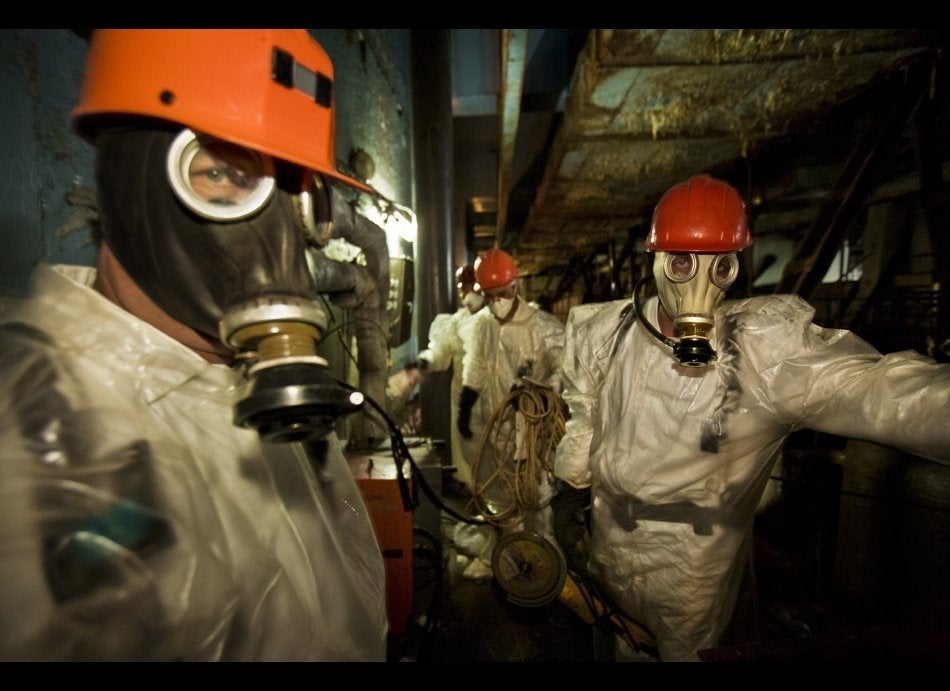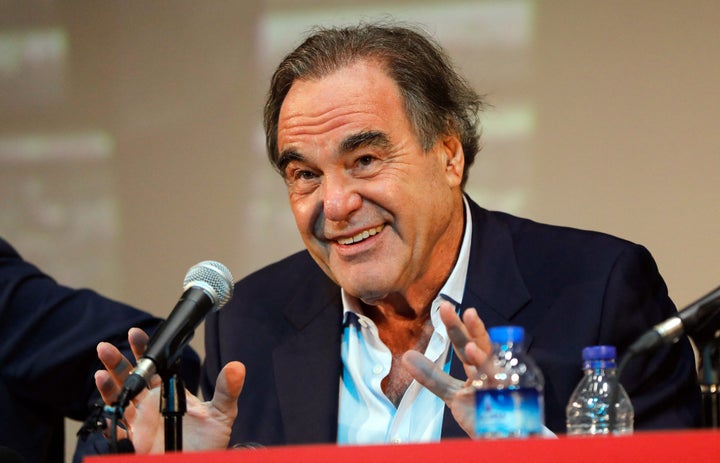
When Oliver Stone’s 1986 Vietnam War movie “Platoon” showed the gore and mental toll of combat, veterans accused the director of portraying soldiers in an ugly light. When 1991’s “The Doors” depicted Jim Morrison’s battle with addiction, the rock star’s bandmate said Stone had “assassinated” the singer’s reputation. When Stone interviewed Cuban leader Fidel Castro and Russian President Vladimir Putin for documentaries meant to provoke Americans with starkly different perspectives on U.S. foreign policy, critics panned the Oscar winner as a stooge for strongmen and an “unrepentant contrarian,” aging gracelessly into a “loony conspiracy”-peddling septuagenarian.
Nuclear energy, the subject of his latest film, is no less of a lightning rod. Perhaps that’s why “Nuclear Now” feels like watching a Gonzo “60 Minutes” special. Stone admits that he, like many people, once registered atomic power as indistinguishable from images of menacing mushrooms clouds and hazmat horrors. To Stone, a clear-eyed review of the facts alone in an age of climate chaos seemed provoking enough on its own.
Over the next hour and 45 minutes, Stone goes on a journey familiar to many who have wondered whether atomic energy and radioactive waste pose a more urgent threat than global warming. “Nuclear Now” answers the question with a clear no, offers a compelling explanation for how atomic energy went into decline and makes a well-researched case for why the world needs a reactor-building renaissance.
Stone takes us through the history of fission from the European scientists who discovered radiation to the United States’ attempt to sell the world on nuclear energy less than a decade after dropping atomic bombs on Hiroshima and Nagasaki.
In his telling, cribbing an eyebrow-raising discovery from the nuclear engineer and consultant (and interviewee in the film) Rod Adams, powerful monied interests had it out for nuclear energy from the start. Just months after President Dwight Eisenhower delivered his famous “atoms for peace” speech, vowing to unite humanity with abundant nuclear energy, the Rockefeller Foundation asked the National Academy of Sciences to study the health effects of radiation.
The government research body, whose president served on the oil tycoon family foundation’s board, put out a dire and later discredited report on the risks of radiation a few years later. The New York Times, whose publisher also served on the Rockefeller Foundation’s board, reported the findings on its front page under the headline: “Scientists Term Radiation A Peril To Future Of Man.” Environmentalists, in Stone’s view, became eager pawns as left-wing activists merged the fight against atomic weapons with that against nuclear power.
The narration is aided by abundant visual charts that help viewers understand why few experts believe solar panels and wind turbines can replace fossil fuels alone, illustrating how much less land nuclear uses and how much more often reactors generate power.
In the movie’s second half, Stone digs into the intricacies of different nuclear technologies, walking the audience through the differences between today’s giant water-cooled reactors and the sodium-cooled “microreactors” startups are attempting to commercialize. He also highlights efforts by the Asian, African and Latin American countries whose energy sources will determine the planet’s future temperature to build their first nuclear reactors, even as Germany and the U.S. decommission perfectly good atomic power stations.
The movie doesn’t shy away from the fact that Russia is the primary vendor for nuclear technology, constructing most of the world’s new reactors outside of China. But Stone grapples only in passing with the reality that Putin’s invasion of Ukraine last year supercharged the growing interest in nuclear energy and continues to animate efforts in the U.S. and Europe to reverse atomic decline. It’s a glaring omission from an auteur whose cozy relationship with the Russian leader has made many question Stone’s judgment and credibility.
Even so, “Nuclear Now” is a comprehensive and credible corrective to decades of atomic mythmaking — less timely than badly overdue. But then again, I’m a reporter who writes about nuclear energy, so don’t take it from me.
The New York Times’ one complaint was that the film’s wonky dive into new reactor technologies “veers somewhat into the weeds.” While The Wrap’s review found the 105-minute movie “dull,” the writer couldn’t help but applaud the “undeniably informative” film as “commendable.” Variety flat-out called it a “vital and grounded movie that demands to be seen.”
Last week, a few hours before seeing “Nuclear Now” at a premiere screening in Manhattan’s East Village, I spoke to Stone and his collaborator Joshua Goldstein, whose book with Swedish nuclear scientist Staffan Qvist, “A Bright Future,” inspired the movie.
We discussed a range of issues, from how radiation works to why Hollywood is responsible for a widespread misunderstanding of the risks associated with nuclear power.
Stone called out actor Jane Fonda for opposing nuclear energy after her 1979 film “The China Syndrome,” depicting a disaster cover-up at a nuclear power plant, came out coincidentally just days before the Three Mile Island accident. He said Ralph Nader’s effort to close nuclear stations was such a historic mistake it may end up overshadowing the consumer-advocate-turned-presidential-candidate’s other accomplishments in future history books. We spoke over Zoom for about 35 minutes.
Why make a film on nuclear energy?
Oliver Stone: I’ve done 20 feature films and 10 documentaries. To me, this is the most important subject I could address. There’s nothing that looms over us as much as climate change. I’ve been very aware of it since the Al Gore film. In 2019, I ran across Josh Goldstein’s book, “A Bright Future.” It’s a nice title. But I think “Nuclear Now” is more urgent. The book is very well laid out, thoughtful, reasoned, makes sense and elemental in the sense that it doesn’t get stuck on the stuff that was confusing to me, which is all the negatives about nuclear. I’ve learned a lot since then.
It seems to me as an outsider that we lost our mind with fear in the 1970s. If you look at my films, you know there were a lot of lies. And over time it turned into this massive lie about nuclear energy that is really evident if you think it through.
Josh gives a very reasonable explanation of radiation. That it’s there. It’s part of our lives. We live with low-level radiation. Yet somehow, with the Rockefeller Foundation’s influence, we were derailed from a very hopeful start in the 1960s and ’70s. Dwight Eisenhower had the right idea. John Kennedy had the right idea. We should have kept going with nuclear. We’d have had a nuclearized society by the 2000s. In my opinion, we wouldn’t even be talking about this climate change bullshit because the world would have followed. Instead, we completely diverted.
So, in your view, why did nuclear go into decline in the U.S.?
Stone: The worst accident was Chernobyl. We discuss that in the film. We go to Russia. We talk to scientists who were involved and we show what Chernobyl was really about, what happened to the 15 front-line rescue workers who died of radiation poisoning that they were not equipped to deal with. It was badly done through the whole thing, from the top down. The containment structure [for the reactor, which all modern nuclear plants have] was not there. Radiation leaked. And the World Health Organization and the United Nations estimated that 4,000 people died from the impact over time. But that’s nothing compared to what you keep hearing about being this huge disaster.
We live with the consequences of radiation. The Earth is filled with radiation. That’s what people don’t understand. They’re frightened because of the concept that it’s contamination and that any amount can hurt you. That’s not true if you look at the DNA studies that were done on the body’s ability to replicate itself. We have to go by science, not faith.
Three Mile Island was a complete joke. It was a big disruption of work. Nobody died. Yet it was made into this massive hysteria by the film “The China Syndrome.”
“Look at the horror films of the 1950s. My business, the film business, did no favors to nuclear at all. You saw monsters everywhere. People get these crazy ideas. This is what fear does to a society. It ruins progress.”
- Oliver Stone
You referred to the Rockefeller Foundation’s money. What powerful forces do you see behind the anti-nuclear movement?
Stone: You’re going to take me into conspiracy. But you could also say it’s a business competition.
The oil companies were obviously never excited about nuclear. At the origin point of going that way, when Eisenhower declared his atoms for peace program, the Rockefeller Foundation tipped the scales on a report — it was their scientists — and they said on the front page of the New York Times that any amount, any amount, of radiation is dangerous to the body. Which is bullshit! And we know it now. It has to be called out. That kind of thinking permeated and gave birth to this idea that radiation is a complete horror.
Also, look at the horror films of the 1950s. My business, the film business, did no favors to nuclear at all. You saw monsters everywhere. People get these crazy ideas. This is what fear does to a society. It ruins progress. As a result, now we’re in a hole. Still, people won’t face the truth. We need nuclear in a massive way in order to solve this climate change problem. Will we go there? It’s still very doubtful because people are resistant to the idea. Older people are. The younger generation I find is very open to it. Our movie is part of that thrust.
What are the limits you see to renewables on one side and carbon capture technology on the other?
Stone: They’re overrated. Tell him.
Joshua Goldstein: We like all attempts to decarbonize, be it with sun, wind, hydropower, carbon capture and sequestration, batteries. All that’s good. The trouble is that when you run your whole grid on that, it gets very expensive and very difficult to do. The grid has to handle the heaviest demand date of the year, when everybody wants air conditioning to turn on at once. You don’t want the grid to go down. So if it happens to not be a sunny day or a windy day, you have a huge hole to fill.
Right now, that’s being done with natural gas, which is a fossil fuel and puts carbon into the atmosphere. Natural gas is methane, which leaks out along the way and is a very potent natural gas, much worse than carbon dioxide, although much shorter lived. But for the next few decades, it’s adding a lot to the problem. So this idea of wind and solar backed up with natural gas is not really getting us to a solution.
Hydroelectricity is great from a climate change point of view because you can let the water out of the dam when you need electricity and actually produce it when you need it. The trouble is that, if you’re an environmentalist, hydroelectricity is damming up valleys and ecosystems.
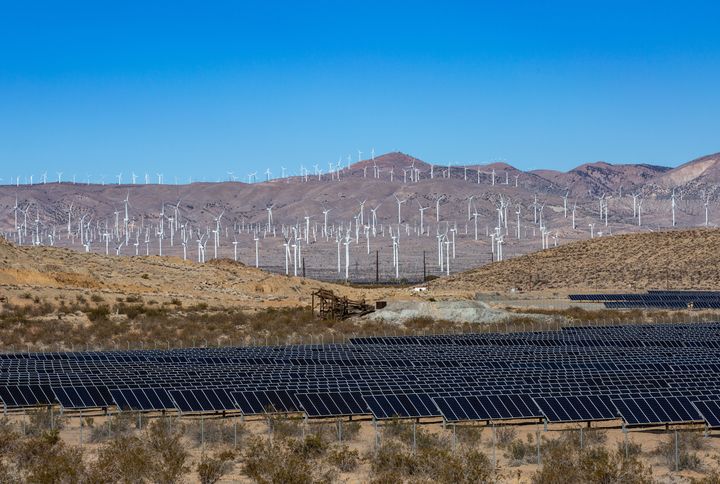
Well, plus it’s sensitive to droughts.
Goldstein: Yes, it’s sensitive to drought. But before you even get to drought, you have the Mekong River watershed just being devastated by all the hydro being built upstream in Southeast Asia. If there is a way to get the electricity when you need it cleanly and without carbon emissions, that’s better. And that’s nuclear energy.
All the countries that have managed to decarbonize and get rid of fossil fuels have done it either with nuclear alone, like France, or nuclear with hydroelectricity, like Sweden. Or a few lucky countries like New Zealand, Norway and Brazil have a lot of hydro. But if you’re Germany, you can’t do a lot of hydro. So then you have to try to do it with a combination of batteries, which are still way too expensive, and natural gas. Except in Germany’s case, it’s coal that’s backing up the renewables.
Then you have things like biomass in Finland and the United Kingdom.
Goldstein: Biomass is very bad for the atmosphere. It’s as bad as coal. And they’re cutting down mature forests to burn the trees, then calling it “green” because it’s so-called renewable because someday the trees will grow back. Nuclear, because it’s so concentrated, that’s what makes it environmentally friendly. You can do it with such a small plant. The mining and transportation is so much smaller and the waste is so much easier to handle than, say, coal waste that goes out in the atmosphere, kills people with particulate matter, and leaves behind coal tailings.
Oliver, you’ve obviously been to Russia many times. You’ve interviewed President Putin. And you’ve been asked plenty of times about your views on the war in Ukraine. I’d like to come at this another way.
Russia has steadily been expanding its fleet of nuclear reactors. It’s been exporting its technologies across Asia and Africa ― I’ve heard stories from analysts about how Moscow’s state-owned nuclear company Rosatom wines and dines energy officials from developing countries, in stark contrast to the U.S. To boot, Russia has a monopoly on certain types of nuclear fuel like HALEU and offers services that the U.S. doesn’t, like recycling. What has the Kremlin understood about nuclear energy that we haven’t, and what does it mean for the U.S. going forward?
Stone: I look at it as positive. What Russia does to help the world, providing these reactors and fuels, is good. That’s a good thing! We have to expand the whole network. I wish there was more of it. The Chinese are also very advanced. Of course, they have their own problems at home with coal. They have to get rid of coal. But they are designing very promising new reactors.
I’m sure most Americans at this stage see the enmity between these two countries. I don’t. There’s no place in this climate race for survival for war. There’s no place for this competition, hatred and ideology.
Goldstein: You mentioned Russian fuel. That started with a good thing. The United States took a lot of Soviet nuclear weapons and downgraded them into what could be used for reactor fuel. Every light switch you turned on in the United States for 15 years was powered 10% by Soviet nuclear weapons dismantled after the Cold War. That was great. When that ran out, we got out of the habit of producing nuclear fuel.
We started buying from Russia because it was cheaper. We don’t need to get HALEU — which is high-assay low-enriched uranium, and is more potent than what we get for our plants — from Russia. There’s plenty of uranium in Kazakhstan, Canada and Australia. You name it. The Russians, because they were doing this cheaply, we got into the habit of buying from them, sort of like how the Germans got into the habit of buying natural gas from Russia. What could go wrong? Now we’re in a fix to try to source this fuel, but that will be worked out in a couple of years.
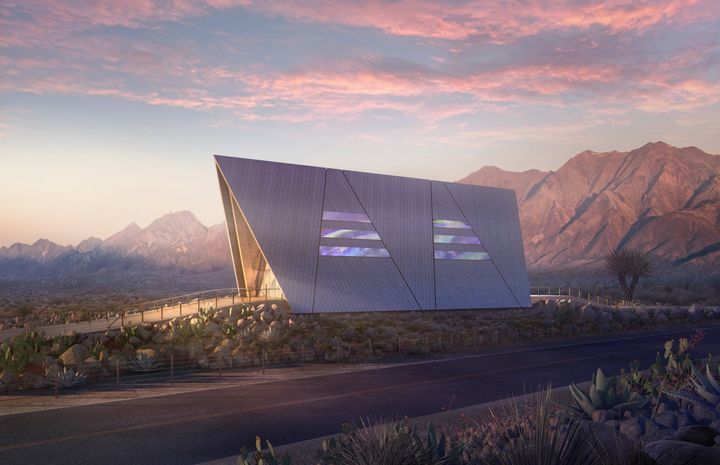
How do you see the war in Ukraine affecting the politics of nuclear energy now? Part of the initial pitch for atomic power was that it provided a degree of energy sovereignty that oil and gas supply chains don’t, as the rush to get off Russian gas has reminded us.
Goldstein: It opened up a lot of support for nuclear in Europe. Maybe not in Germany, per se. But elsewhere, especially in Eastern Europe. This is the same thing that happened in France in the 1970s when the oil supply was cut off [during the OPEC oil embargo]. They were dependent on it and realized some foreign country could bring their economy to its knees. France developed nuclear energy to control its own destiny.
Stone: Unfortunately, Germany is so stupid that their economy is now really in jeopardy. The EU is not going to be what it once was. Germany is taking this whole anti-nuclear position that really threatens its economy.
Are you similarly concerned about Taiwan’s nuclear phaseout?
Stone: No, not particularly. America is concerned and makes big noise about Taiwan. A lot of my friends come back from Taiwan and say that the Taiwanese people don’t feel the same way as our newspapers.
The chances of a Chinese invasion are certainly debatable, but energy blockades are not, and Taiwan is shutting down its last nuclear reactors by 2025.
Goldstein: They may yet come to their senses. South Korea had a very good nuclear program. They just finished building these reactors in the United Arab Emirates on time and on budget. But there was a film called “Pandora” five or six years ago that scared everyone. It helped get an anti-nuclear government elected. Now there’s a pro-nuclear government. The same thing happened in Sweden, where there was an anti-nuclear government replaced by a nuclear-friendly administration.
If you go anti-nuclear and it’s a threat to a country’s stability, economy, jobs and having the lights turn on when you flip the switch, then people will vote in a new government. I’m not saying anything about the politics of Taiwan and which government should be in. But as lots of people reconsider phasing out nuclear, maybe Taiwan will as well.
One place that seems to exemplify the promise of nuclear energy is Finland, where I was around this time last year. I not only saw the world’s first permanent repository for nuclear waste, I saw Western Europe’s first new reactor in 15 years ― 25, if you don’t count Czechia as part of that region.
After visiting the site, I spent a few hours walking around the nearby town of Rauma, a UNESCO World Heritage site. Every single person I talked to on the street supported nuclear power and had total faith in the engineers at the plant to keep everyone safe. Now, this is a highly educated, ethnically and religiously homogeneous country with comparatively low levels of inequality. It’s hard to imagine that kind of civic trust in the U.S., where plummeting faith in institutions has correlated with the rise of conspiracy theories.
Can we have a nuclear renaissance in a country with as little public trust as we have here?
Goldstein: We’re trying to build two new reactors in Georgia and they’re just coming online. They’ll be the first reactors ever built under the Nuclear Regulatory Commission. The NRC has been around almost 50 years, and it’s clearly been very efficient at stopping us from building new reactors.
Stone: It’s not about safety. The FDA is supposed to be about safety. It’s about restriction.
Goldstein: When the FDA regulates a new medicine, they’re weighing the benefits and risk and deciding what’s the benefit to society. But the NRC is only concerned about the risks. Safety is their mandate. And when they stop us from building nuclear plants and we build coal and gas plants instead, that’s not their problem. It’s like I had a doctor once tell me, ‘My job is to make sure you die of someone else’s disease.’
In a place like Finland, there is more trust in the government. Those places, like Finland and Sweden, have been better for nuclear energy. But also, the places that understand nuclear better like it more. If you do the polling, people who live close to a nuclear plant versus people who live far from it, or people who understand it well [versus] those who say they couldn’t tell you much about it. Those who understand support it more. Finland, they’ve been living on nuclear energy for quite a while. They’re building a repository for spent fuel quite successfully. People understand it and they’re not afraid of it, which is one of the big themes of the film.
“In a place like Finland, there is more trust in the government. Those places, like Finland and Sweden, have been better for nuclear energy. But also, the places that understand nuclear better like it more.”
- Joshua Goldstein
But what can be done to build more public trust? Let me put this in real terms.
Just last night, I was at the decommissioning board hearing for the Indian Point nuclear plant in Cortlandt, New York. I listened to people express a lot of fear over the release of tritium-laced cooling water from the plant into the Hudson River. They perhaps didn’t fully understand that such releases have been happening for decades, and that it’s occurring at levels far below the natural amounts of this radioactive isotope already found naturally in the environment. But they’re learning about a radioactive waste product being pumped into their river as something new. And they see a company with a profit motive to release the tritiated water because it’s the cheaper option than storing it for the decades it’d take to decay.
These people hear that the levels of tritium released are far below the drinking water limits set by the Environmental Protection Agency. But then they see that, well, just a few years ago, the EPA revised its drinking water limits for PFAS, the so-called forever chemicals used in Teflon, from more than 400% higher than what the agency now says is safe.
Goldstein: Antinuclear people are very afraid, and they look for things to justify their fears. This tritium thing has come up in Japan at Fukushima, in Indian Point, and in Massachusetts where I live at the decommissioned Pilgrim plant. You hear about how they’re going to put quote-unquote “radioactive water” into the Hudson River, Cape Cod Bay or the Pacific Ocean. And there’s no sense of scale about it.
The amount of radioactivity in tritium is very tiny, short-lived, and not biologically accumulating. It’s about the most harmless thing you can think of. And the quantities of it are just tiny. There’s tritium in exit signs. I’m looking at one right out the window here. I think the total amount of tritium they want to release from Indian Point is the same as one exit sign if you dumped the exit sign in the Hudson River.
It gets absurd at this point. We live with background radiation that’s much higher than that. This whole idea that any level of radiation is going to have a bad health effect, it’s all based on a study from 70, 80 years ago when some scientists said DNA can’t repair itself. Well, we just had a Nobel Prize for DNA repair. We know we can repair it. And of course we can, because we live on a planet filled with radiation. The idea that we’re so vulnerable to that tiny amount of tritium, of all things, that its little weak electrons are going to mess us up for life, is kind of crazy. But as long as people are afraid, that’s what you’re going to get.
The power of a film like this is to get people at a more emotional level than a book can do or a newspaper can do and try to get at that fear at a more visceral level where people say, oh, now I understand and I’m less afraid.
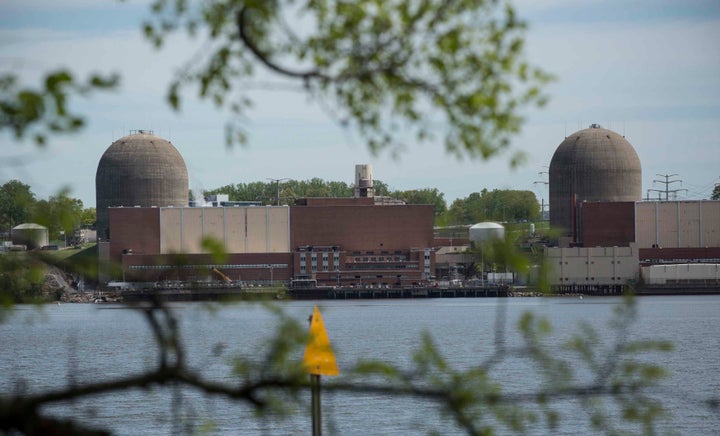
Was there a moment like that for you, Oliver, where the magnitude of what this technology could do really sank in?
Stone: There was this moment with Rod Adams [a nuclear engineer interviewed in the film] was holding up his pinky. And he said in this tiny pinky’s worth of uranium would be equivalent to one ton of coal. It would cost less than a buck, and the coal would cost $100.
You think about Marie Curie and Albert Einstein. They’re not dumb. They saw this potential. Obviously, World War II fucked up the timing of it, right? It came along, and people got it into making bombs. But people still conflate making bombs with nuclear energy, and it’s a huge problem. We have to get back to the origins of making this movie, which is to answer the basics: What is it? What is nuclear energy?
It takes time. But we have to clear up the details of the past. We have this chance. Historically, it will be noted that [retreating from nuclear] was a disastrous decision. Ralph Nader is not going to come out well in history. I believe in his car seatbelt thing, and Jane Fonda was great on Vietnam. But sometimes, you’re wrong. The guy who founded Greenpeace said himself that we did a lot of good things with Greenpeace, but we got one thing wrong: nuclear energy.
Broadly speaking, one of the bright spots for nuclear power is that both parties in the U.S. support it. But then you have Democrats who haven’t really taken responsibility for kiboshing the permanent storage site at Yucca Mountain or changing the law to make it so the government can explore an option beyond that site in Nevada. And Republicans are trying to repeal a bunch of clean energy subsidies that nuclear reactors could benefit from. How big are the hurdles in our current politics to doing new nuclear, and which party remains the bigger obstacle?
Goldstein: There is bipartisan support. You have [Sens.] Cory Booker and Sheldon Whitehouse on the left wing of the Democratic Party as big supporters of nuclear energy, and on the right wing of the Republican Party, [former Sen.] Jim Inhofe of Oklahoma for instance, there are very strong supporters of nuclear. They’ve gotten bills going through Congress. The NRC has been slow to respond to those. The Biden administration is pro-nuclear but could be stronger. The Trump administration was pro-nuclear. So it’s not a partisan divide. But the left wing of the Democratic Party needs to rally around Cory Booker a little more and a little less around the Elizabeth Warren types who are still anti-nuclear. In an age of divisiveness and gridlock, if you have something like nuclear, that’s a place to push for some progress.
Stone: When push comes to shove, necessity is the mother of invention. Where are we going to go? It’s going to get worse. It hasn’t gotten better. There’s more carbon. It gets worse and worse and worse. Someday, we’ll have to say, ‘Oh, let’s build some nuclear.’ And it’ll be late. But better late than never. You have these environmentalists waking up. They’re dreaming. They have this idealism in their head about renewables, that the only answer is more and more solar panels and more and more wind turbines. It’s just bizarre. It’s a strange death wish. There’s always a death wish in the world. It’s always been there, but it’s been growing.
Hopefully, if we get lucky, this film will help change the current and it’ll solve itself because people don’t want to kill themselves.
Two more quick questions. First, nuclear fusion — viable commercial breakthrough in our lifetimes or a distraction from deploying more fission?
Goldstein: I’m all for it. It could be the power source of the second half of the century. There are companies that think they can do it faster, and more power to them. I’m all for trying, but I don’t want to bet my grandchild’s future on breakthroughs. The beauty of fission is it’s a proven source. We know from France and Sweden it can be done quickly. The world can follow that example. In the 1970s when all the anti-nuclear stuff got started, it was a new energy source, so who knew if it was going to be safe? After 70 years, we know it works. I’m all for fusion unless people say we don’t need fission because of fusion.
Stone: I totally agree. I can’t see it breaking through. If it does, great.
I apologize for this final one, Oliver. My editor said I had to ask you this. RFK Jr. running for president. What do you think?
Stone: I’m for it! All for it. I think he’s a hero. He’s really in the spirit of the Kennedys and spirit of reform. Out with the old, in with the new.
Would he be a champion of nuclear?
Stone: He will be when I talk to him.
Goldstein: We, uh, don’t necessarily agree on presidential politics, but that’s not what we’re here to talk about today.
Stone [laughing]: Josh is the old Democratic Party.
This interview has been lightly edited for length and clarity.

